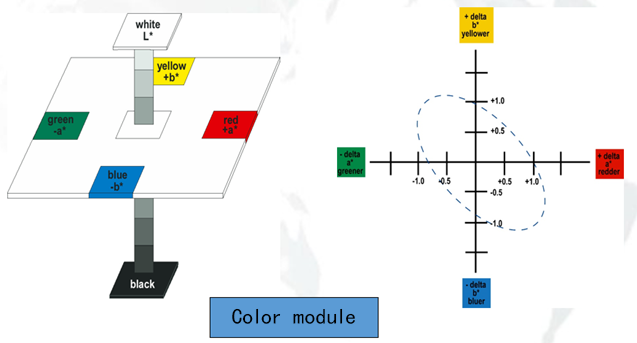三、Perceptual characteristics of visual system
The human visual system has many characteristics in the perception of color and its spatial details, such as visual residue, insensitive to sharp changes in edges, and stronger perception of brightness than color.
Theoretically, every color in nature can be determined by the three primary colors of R, G and B, so the RGB three-dimensional color space model is formed, which can be accurately calculated by mathematical formula.
According to the perceptual characteristics of human visual system to color and spatial changes and color space model, we can design all kinds of digital image data compression algorithms.
Visual system of Human
- • It is believed that color is the result of the visual system's perception of visible light.
- The human retina has three kinds of cone cells with different sensitivity to red, green and blue colors, and a rod-shaped cell that works only under the condition of extremely low light power. Therefore, color exists only in the eyes and brain. Rod cells do not play a role in computer image processing.
- Visible light is an electromagnetic wave with a wavelength of 380 ~ 780nm. Most of the light we see is not light of one wavelength, but a combination of many different wavelengths.
- The human retina senses the color of the external world through neurons. Each neuron is either a color sensitive cone or a color insensitive rod
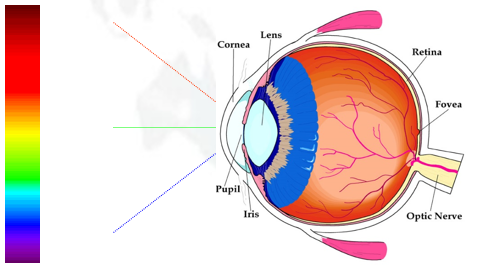 Perceptual characteristics of vision:
Perceptual characteristics of vision:
- Red, green and blue cone cells have different perception of different frequencies of light and different brightness.
- Any color in nature can be determined by the sum of R, G and B, which constitute a three-dimensional RGB vector space.
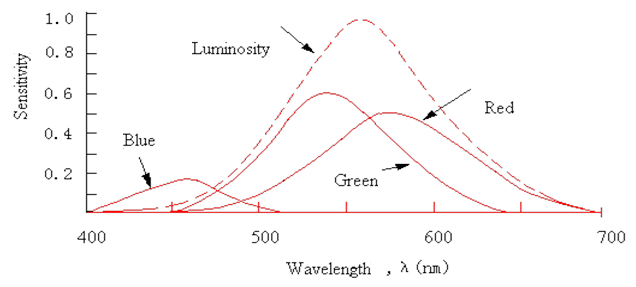
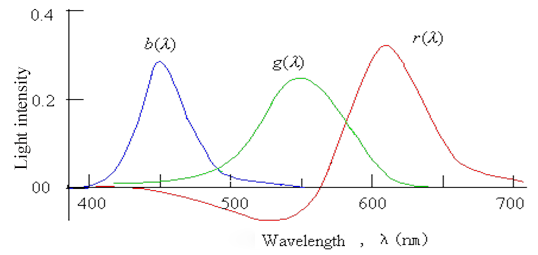 Perceptual characteristics of vision:
Perceptual characteristics of vision:
A group of color samples have the same color under sunlight or a certain light source, but when they are placed under another light source, the color is different
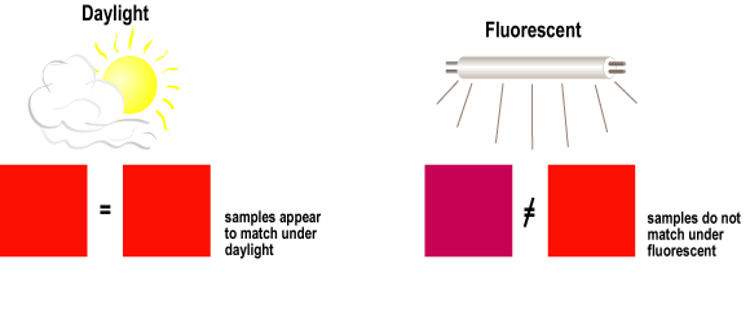
四、Color mode
- RGB additive color mixing mode
- CMY subtractive color mixing mode
- HSB mode
- Lab mode
RGB mode
- RGB mode is based on the mixing principle of three primary colors in nature. The primary colors of red, green and blue are allocated in each color scale according to the brightness value from 0 (black) to 255 (white), so as to specify their colors. When the primary colors with different brightness are mixed, 256 * 256 * 256 kinds of color will be produced, about 16.7 million. For example, a bright red may have an R value of 246, a G value of 20, and a B value of 50. When the brightness values of the three primary colors are equal, gray is generated; When all three brightness values are 255, pure white is generated; When all luminance values are 0, pure black is generated. When the color generated by the mixing of three kinds of color light is generally higher than the original color brightness value, so the method of generating color in RGB mode is also called color light additive method.
CMYK mode, also known as printing color mode, is a processed mode as the name suggests.
- It is very different from RGB. RGB mode is a luminous color mode, and the content on the screen can still be seen in a dark room
- CMYK is a color mode that relies on reflection. How do people read the contents of newspapers? It is the sunlight or light shining on the newspaper and then reflected into our eyes that we can see the content. It needs an external light source. If you are in a dark room, you can't read newspapers
- As long as the image displayed on the screen is expressed in RGB mode. As long as the image is seen on the printed matter, it is represented by CMYK mode. For example, periodicals, magazines, newspapers, posters, etc. are printed and processed, so it is the CMYK model.
- Similar to RGB, CMY is the initials of three ink names: Cyan, magenta and Yellow. K takes the last letter of black. The reason why it does not take the initial letter is to avoid confusion with blue. In theory, only three kinds of CMY inks are enough. When they are added together, they should get black. However, because the current manufacturing process can not produce high-purity inks, the result of CMY addition is actually a dark red, so a special black ink needs to be added to reconcile.
- When C, M, Y and K are mixed into color, with the increase of C, m, Y and K, the light reflected to human eyes will be less and less, and the brightness of light will be lower and lower. The method of generating color in all CMYK modes is also called color subtraction.
HSB mode
HSB mode is defined based on the observation of color by human eyes. In this mode, all colors are described by hues, saturation and brightness.
- Hues refers to the color reflected from or transmitted through an object. On the 0 ~ 360 degree standard color wheel, the hue is measured by position. In normal use, the hue is identified by the name of the color, such as red, orange, green, etc. It is an attribute of appearance.
- Saturation refers to the intensity or purity of the color, which indicates the proportion of gray components in the hue. It is expressed by 0% (pure gray) - 100% (fully saturated color). On the standard color wheel, the saturation from the center position to the edge position is increasing.
- Brightness is the relative brightness of a color. It is usually measured by 0% (black) - 100% (white). Defect: due to the limitation of equipment, it is necessary to convert to RGB mode when displayed on the computer screen and CMYK mode when printed out. This limits the use of HSB mode to a certain extent. In CIE XYZ system, the brightness is expressed by the value of Y, which can be measured. It is expressed by the intensity of reflected or emitted light per unit area. Brightness is measured in units such as candlelight per square meter (cd/ m2).
CIE definition of lightness: it is the corresponding value of people's visual system's perception of radiant brightness, which is expressed by L *.
Lab mode
The prototype of lab mode is a standard for measuring color formulated by CIE Association in 1931. It was redefined and named CIELab in 1976.
RGB mode is a color adding mode of luminous screen, and CMYK mode is a color reflective printing subtraction mode. The Lab mode does not rely on light or pigment. It is a color mode determined by CIE organization, which theoretically includes all colors that can be seen by human eyes. Lab mode makes up for the shortcomings of RGB and CMYK color modes
Lab color is represented by one brightness component L and two color components a and b. The value range of L is 0-100, component a represents the spectral change from green to red, while component b represents the spectral change from blue to yellow, and the value ranges of a and b are -120 ~ 120.
五、CIE1976 Lab chromaticity space and color difference formula
Color communication language
1) Communication language when hue changes: communication language: red, yellow, green, blue, less red, less yellow and so on
2) Communication language when brightness changes: Brightness mostly uses brighter or darker to describe the difference between them;
3) Communication language when the saturation changes: Saturation is described by strong or weak;
- Observation geometry
The different angle of observer inspection also affects the difference of product color. Sometimes, in order to reach an agreement with the customer, it is necessary to observe the object from the same angle. ASTM (American Society for testing and materials) D1729-89 recommends 0 / 45 lighting and observation conditions. The observation method is shown in the following figure:
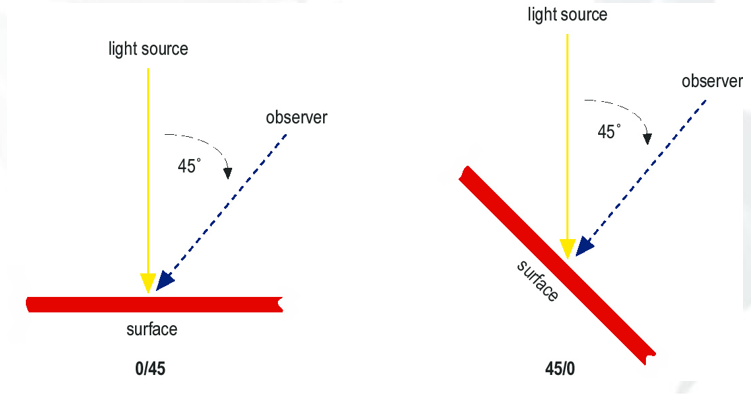
Standard Illuminants
- Standard Illuminants refers to the artificial light source simulating various ambient light, so that the production plant or laboratory can obtain the lighting effect basically consistent with the light source in these specific environments off-site. The standard Illuminants is usually installed in the standard Illuminants box and color measuring instrument. It is mainly used to detect the color deviation of articles, which must comply with the CIE standard of the international lighting society.
- The inner wall environment of the standard Illuminants box has a great impact on the standard Illuminants. It must be a standard dark gray matte surface to ensure that it is not affected by the reflected light of the environment.
Common standard Illuminants
Simulated blue sky sunlight -- D65 light source, color temperature (CT): 6500K
Simulated European store light -- TL84 light source, color temperature (CT): 4000K
Simulated American store light -- CWF light source, color temperature (CT): 4100K
Simulate warm color lighting of family or hotel -- F light source, color temperature (CT): 2700k
●Calculation formula of chromatic aberration
- + L bright - L dark
- + a red - a green
- + b yellow - b blue
- △E( total chromatic aberration )=√ (△a)2+(△b) 2+(△L) 2
- △a(chromatic aberration )=a2-a1
- △b(chromatic aberration )=b2-b1
- △L(lightness aberration)=L2-L1
●Application of chromatic aberration formula
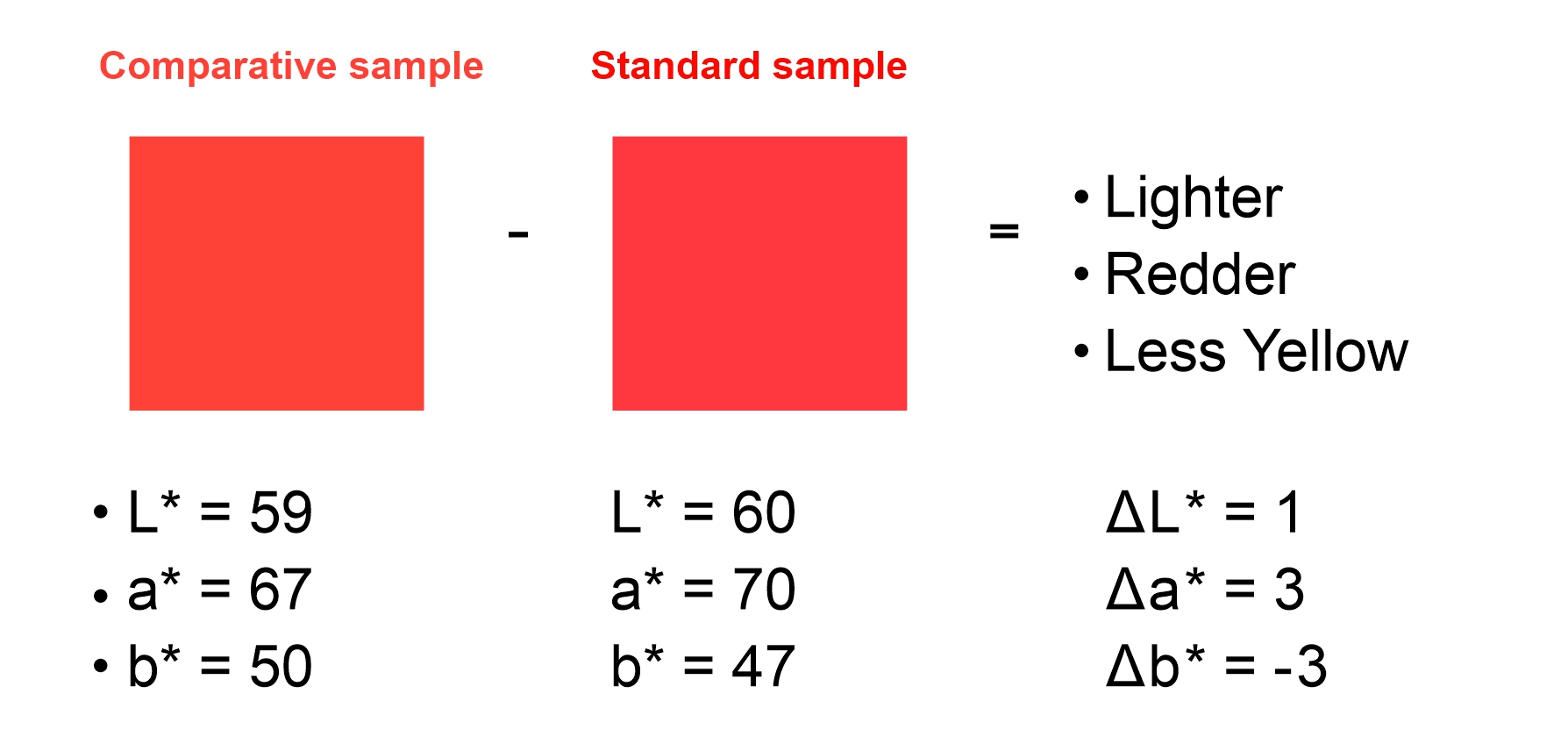
- Two important indexes:
1. Uniformity is very important.
2. The range of set number must be able to confirm the acceptability of the visual difference.
- Tolerance range of △ E in industry standard
0 - 0.25: very small or none; Ideal matching
0.25 - 0.5: minute; Acceptable match
0.5 - 1.0: small to medium; Acceptable in some applications
1.0 - 2.0: medium; Acceptable in specific applications
2.0 - 4.0: obvious; Acceptable in specific applications
4.0- more: very large; Unacceptable in most applications
(Some pictures come from the Internet. If there is infringement, please contact and delete it immediately)
Post time: May-05-2023
